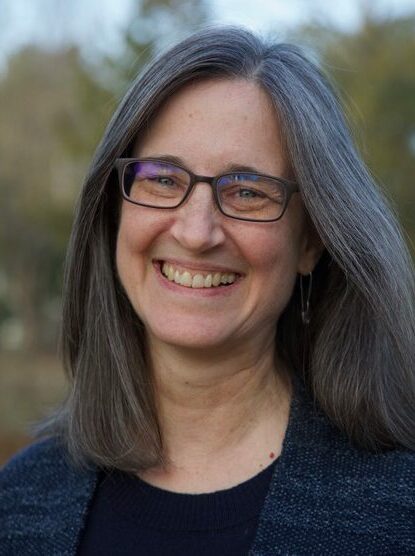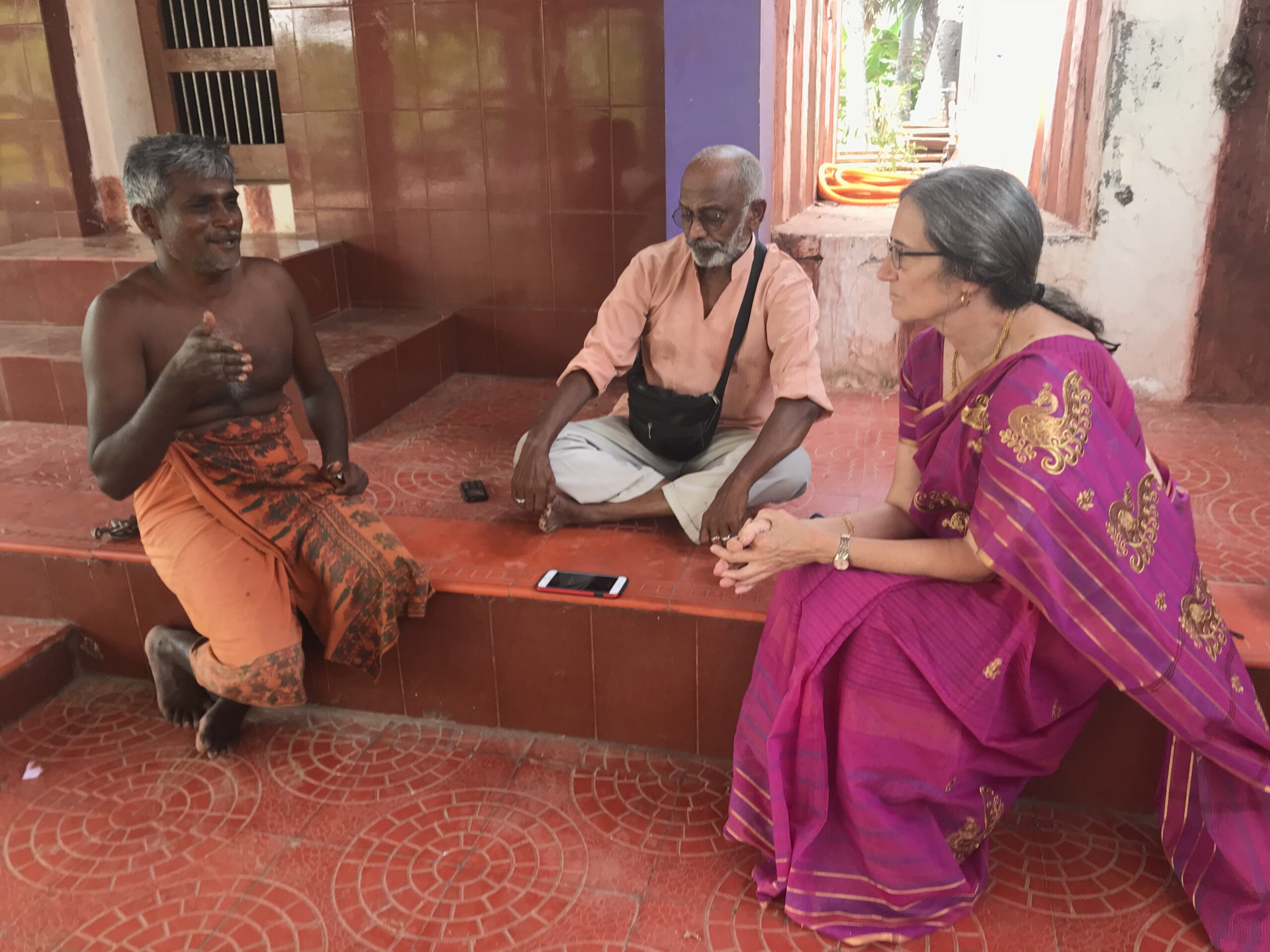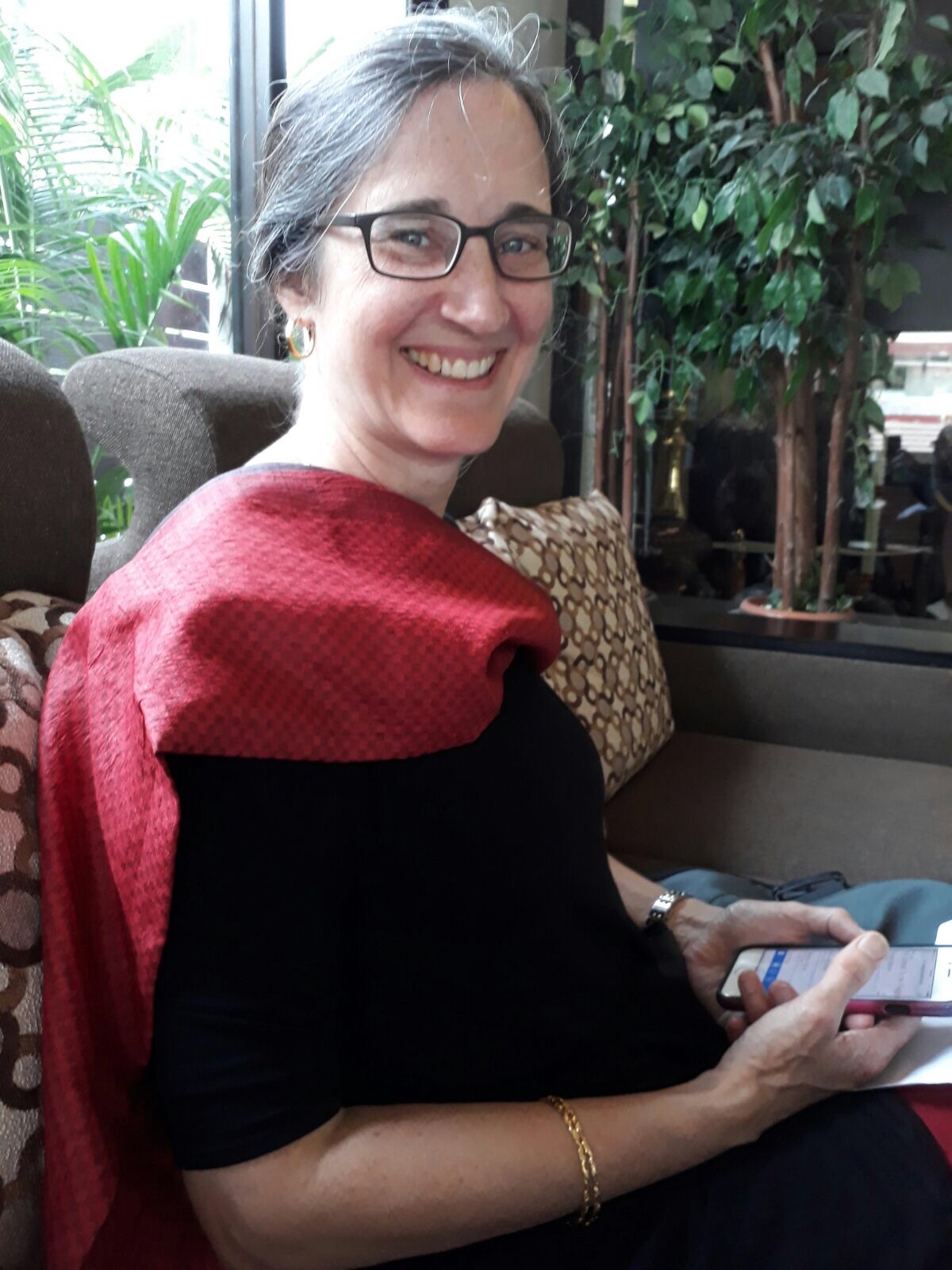 Sara Dickey is a Professor of Anthropology at Bowdoin College. Her research and teaching interests include class identities and relations; intersections of class, race, and caste; film consumption and fan clubs; cinema and politics; heterodox Hinduisms; South Asian modernities; and activists and activist movements in South Asia.
Sara Dickey is a Professor of Anthropology at Bowdoin College. Her research and teaching interests include class identities and relations; intersections of class, race, and caste; film consumption and fan clubs; cinema and politics; heterodox Hinduisms; South Asian modernities; and activists and activist movements in South Asia.
Professor Dickey has received a number of research fellowships from AIIS through the years, including a 1985-1986 AIIS Junior Fellowship, a 1999-2000 AIIS Senior Fellowship, and a 2008-2009 AIIS Senior Fellowship. In today’s fellow profile, she shares with us how the threads and connections that were created during her different AIIS research fellowships have paved the way for multiple, innovative research initiatives including her current NSF-funded project.
How did your participation in AIIS programs help support your overall research and teaching goals?
 My doctoral research, funded by AIIS, set in motion my interests in class, class identities, and class relations. In fact, as I think about it, my three AIIS grants supported both of my first two major projects at especially crucial times in those decades. My junior fellowship produced most of the fieldwork data that informed my early research on filmwatching, while the 2008-2009 senior fellowship later allowed me to focus on producers and critics of Tamil cinema. Shifting gears, my 1999-2000 senior fellowship launched an expanded project on class identities and relations that eventually resulted in my 2016 book, Living Class in Urban India. That project sputtered temporarily when untranscribed cassette tapes—recordings of interviews that I had intended to use as the center of the forthcoming book—were lost in the mid-2000s. But my 2008-2009 fellowship also provided the support necessary to regalvanize that project on class and to collect the data that produced a new set of case studies for the book.
My doctoral research, funded by AIIS, set in motion my interests in class, class identities, and class relations. In fact, as I think about it, my three AIIS grants supported both of my first two major projects at especially crucial times in those decades. My junior fellowship produced most of the fieldwork data that informed my early research on filmwatching, while the 2008-2009 senior fellowship later allowed me to focus on producers and critics of Tamil cinema. Shifting gears, my 1999-2000 senior fellowship launched an expanded project on class identities and relations that eventually resulted in my 2016 book, Living Class in Urban India. That project sputtered temporarily when untranscribed cassette tapes—recordings of interviews that I had intended to use as the center of the forthcoming book—were lost in the mid-2000s. But my 2008-2009 fellowship also provided the support necessary to regalvanize that project on class and to collect the data that produced a new set of case studies for the book.
All of this work is central to where I am now, although on the surface my new project may look quite different. For the first time in my research career, I am focussing on religion and caste, examining “disjunctive identities” through the eyes and experiences of urban Hindu Nadars. Nadars were historically assigned one of the lowest caste rankings in the southern Indian region and today comprise one of the wealthiest caste groups in Madurai (meaning, on average, families hold a middle-class standing). The thread that ties this subject to my previous projects is a focus on the performance and interpretation of identities within systems of inequality.
AIIS has been important to my research over the years in other ways as well. The staff in Chennai and Madurai have supported me in key ways, helping me to make connections with research associates, scholars, and institutions. Back in 1985-87, when I was first in India, I also got to hang out on the verandah of the AIIS Tamil program center, and I met some of my favorite South Asianist scholars there.
As for teaching, my 2008-2009 grant contributed directly to the course I teach on Indian cinemas, enabling me to add an updated segment on contemporary film production and criticism; and all three of my AIIS grants have contributed to coursework on class and on modernities and activism in South Asia.
Congratulations on your NSF grant! Can you tell us about your current research project?
 This project explores what it is like for an entire self-identified community to live with two disjunctive identities that are publicly visible. My focus lies in how Hindu Nadars in Madurai try to manage the disjunction between the stigma of their caste and the honor of their class. I investigate these questions through two key sites: religious festivals and caste associations. The fierce lineage deities worshipped most frequently by Nadars are disdained (if feared) by the majority of middle-/upper-class and middle-/upper-caste urban residents as too wild for “decent” worship; devotees are then associated by others with the qualities of backwardness and frenzy—the opposite of respectable middle-classness. On the other hand, most Nadar local caste associations (uravinmurai) direct their often substantial funds to civic projects such as the building of schools, hospitals, and marriage halls—highly reputable institutions associated with disciplined modernity.
This project explores what it is like for an entire self-identified community to live with two disjunctive identities that are publicly visible. My focus lies in how Hindu Nadars in Madurai try to manage the disjunction between the stigma of their caste and the honor of their class. I investigate these questions through two key sites: religious festivals and caste associations. The fierce lineage deities worshipped most frequently by Nadars are disdained (if feared) by the majority of middle-/upper-class and middle-/upper-caste urban residents as too wild for “decent” worship; devotees are then associated by others with the qualities of backwardness and frenzy—the opposite of respectable middle-classness. On the other hand, most Nadar local caste associations (uravinmurai) direct their often substantial funds to civic projects such as the building of schools, hospitals, and marriage halls—highly reputable institutions associated with disciplined modernity.
I have completed eight months of initial fieldwork through my NSF Cultural Anthropology grant. My time to date has been divided primarily among interviews with Nadar families and temple officiants, participation in religious festivals (and weddings!), and meetings with uravinmurai members and officers. Recently, I also began asking Nadar and non-Nadar acquaintances to watch a short video with me of a Nadar lineage temple’s annual festival. (The video is compiled from footage that I shot from 2009 to 2020, with temple leaders’ permission.) As I had hoped, this method elicited a great deal of commentary from my co-viewers. Hindu Nadars comment on what they, their families, their community, and the deities gain from their worship practices; these discussions also reveal a range of tastes for appropriate worship practices among Nadars themselves. Non-Nadar Hindus respond to the videos with vivid reflections about the (often stark) differences that they perceive in their own worship practices.
Was your experience with AIIS helpful in laying the groundwork for this project? If so, how?
 Past support from AIIS was crucial to building my current interests. Research undertaken with AIIS funding heightened my attention to the production of identities of self and other, and to the direct impacts of this production on the politics of inequality. In fact my current project grows immediately out of research that appeared in the final chapter of Living Class in Urban India. The fieldwork for that chapter began at a 2009 festival at a Nadar lineage’s ancestral temple. The chapter focusses on a young Nadar videographer who, soon after that year’s festival, was called to inherit a position as the head “god dancer” at the temple. Because this ritually revered role involves possession by the ferocious deity, many urban residents denigrate it as uncivilized and lower-class/-caste. This young man, who is named Murugan in the book, faced an agonizing choice between his lineage responsibilities and his middle-class identity. Charting the course of the resolution of this crisis led directly to my interest in Nadars’ balancing of caste and class identities.
Past support from AIIS was crucial to building my current interests. Research undertaken with AIIS funding heightened my attention to the production of identities of self and other, and to the direct impacts of this production on the politics of inequality. In fact my current project grows immediately out of research that appeared in the final chapter of Living Class in Urban India. The fieldwork for that chapter began at a 2009 festival at a Nadar lineage’s ancestral temple. The chapter focusses on a young Nadar videographer who, soon after that year’s festival, was called to inherit a position as the head “god dancer” at the temple. Because this ritually revered role involves possession by the ferocious deity, many urban residents denigrate it as uncivilized and lower-class/-caste. This young man, who is named Murugan in the book, faced an agonizing choice between his lineage responsibilities and his middle-class identity. Charting the course of the resolution of this crisis led directly to my interest in Nadars’ balancing of caste and class identities.
But I can trace my involvement with Murugan and his family, and the role of AIIS funding in laying the groundwork for this project, even further. I know Murugan because we have a mutual friend pseudonymously named Anjali, whom I first met 35 years ago when I was beginning my AIIS-funded dissertation research. In 1999—also during an AIIS fellowship period—I met Murugan and his family. Anjali and Murugan and their extended families, along with others whom I have met thanks directly to AIIS support, have made vital contributions to my new research project.
Anything else you’d like to share about your fellowship experience that may be helpful for those considering applying?
Make use of the many local resources to which AIIS may be able to provide access. As I said, I have been blessed by the connections that AIIS staff in India have generously provided me. Resources might include, for example, connections with local organizations, leaders, practitioners, or scholars, or with potential research assistants and associates. Most recently I worked with my faculty contact at my affiliated Indian university to find Masters and Ph.D. theses on subjects related to my research – sources of knowledge that are often otherwise inaccessible.
More information on our fellowship programs can be found on our website at www.indiastudies.org/research-fellowship-programs/.